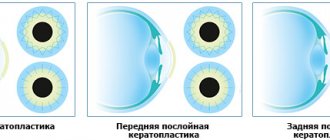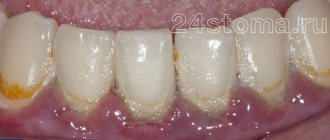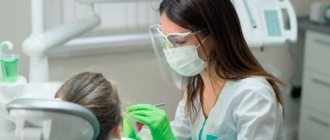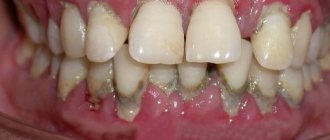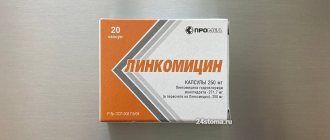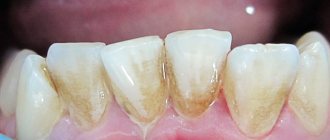The main criteria for the treatment of gingivitis are:
- Complexity
Each specific case requires a number of therapeutic procedures. Both local and general treatment are necessary. Therapy should be aimed not only at relieving symptoms, but also at the causative factors.
- Individuality
The features of the clinical course, associated problems (their presence and nature), as well as factors of local and general defense of the patient’s body (the state of the immune system) must be taken into account.
- Systematicity
Chronic forms of the disease require regular courses of maintenance therapy to bring the disease into stable remission.
Treatment tactics depend, first of all, on the form of the disease. Let us consider in detail the specifics of treatment of three forms of gingivitis. This will help you understand the basic principles of therapy and roughly explain how your dentist will treat gingivitis.
Classification of gingivitis according to ICD:
- K05.0. Acute gingivitis
- K05.00 Acute streptococcal gingivostomatitis
- K05.08 Other specified acute gingivitis
- K05.09 Acute unspecified gingivitis
- K05.1. Chronic gingivitis
- K05.10 Simple marginal gingivitis
- K05.19 Chronic unspecified gingivitis
- K06.0. Gum recession.
- K06.1. Gingival hypertrophy.
- K06.2. Lesions of the gums and edentulous alveolar margin caused by trauma.
- K06.9. Changes in the gingiva and edentulous alveolar margin, unspecified.
Treatment of chronic catarrhal gingivitis
- The first and mandatory step in therapy is professional teeth cleaning - removing tartar and smoothing the surface of the teeth using ultrasonic and sandblasting devices. The steps of the procedure are shown in the figure below.
- Training in proper individual oral hygiene.
- Elimination of local factors that contribute to the formation of plaque - treatment of caries, correction of orthodontic and orthopedic structures.
- Relief of a problem that aggravates the effect of a microbial factor - elimination of injuries, treatment of pathology of the attachment of the frenulum (plastic surgery to enlarge the frenulum).
- Antibiotics and anti-inflammatory drugs in the form of oral baths, applications, irrigations are used for gingivitis at the stage of a pronounced inflammatory process.
- To improve the process of tissue regeneration, keratolytic agents are used (sea buckthorn and rose hip oil, solcoseryl, vitamins A and E).
- General strengthening therapy is necessary - the use of vitamins, adaptogens, antioxidant therapy, and means to normalize metabolism.
Diagnostics
Diagnosis of gingivitis is carried out in several ways, which are used in combination. At the initial stage, the doctor collects anamnesis:
- The diet and bad habits are revealed;
- The reasons for tooth extraction/loss are clarified;
- Genetic predisposition is determined.
After this, an examination of the oral cavity is carried out, the depth of the dental canals is studied with a special probe. Additional methods of diagnostic testing include x-rays and testing the sensitivity of the pulp.
The following methods can be used to diagnose gingivitis:
- Fedorov-Volodkina index;
- RMA index;
- Schiller-Pisarev test.
Treatment of ulcerative gingivitis
Therapeutic measures should be aimed at eliminating the inflammatory process, increasing the patient’s body’s resistance to microbes, and preventing the influence of local factors that provoke necrotizing ulcerative gingivitis. Let's consider the main stages and principles of the treatment.
- Professional oral hygiene.
- Antibacterial and anti-inflammatory therapy.
- One of the features of the treatment of necrotizing ulcerative gingivitis is the removal of necrotic areas of tissue; Hydrogen peroxide and chlorhexidine are usually used.
- The use of keratolytic agents, vitamins, adaptogens.
- Training in the rules of proper oral hygiene, as well as monitoring hygienic skills.
- One of the features of the ulcerative form of the disease is severe pain, therefore the treatment of gingivitis, due to the difficulty of carrying out normal hygienic care, is accompanied by the use of antiseptics and anti-plaque agents.
- Elimination of factors contributing to the formation of plaque on the surface of teeth.
- Elimination of the problem that aggravates the proliferation of microorganisms and their pathogenic effects.
Gingivitis - symptoms and treatment
The development of gingivitis begins with the formation of plaques from dental plaque. They form after lack of proper oral hygiene for 1-2 days. The most common places for plaque formation are interdental spaces and the cervical area.
A film called pellicle is formed from saliva and fluid secreted by the gums. Normally, it performs a protective function, but in the initial stages of gingivitis it promotes the adhesion (sticking) of bacteria that are present in the oral cavity even in a healthy person. Usually these are aerobic cocci and rods.
Microorganisms actively reproduce, and an anaerobic (oxygen-free) environment is formed in the depths of their colony. This creates optimal conditions for the proliferation of aggressive gram-negative microflora. These bacteria produce toxins that can penetrate tissue and destroy the mucous membrane, which leads to erosive changes in the epithelium.
The body tries to resist the damaging effects and in response launches an inflammatory reaction to destroy pathogenic factors. In some cases, the immune system copes with the microflora on its own, but more often the inflammation progresses or becomes chronic.
The destructive effect of microorganisms and the inflammatory process lead to deterioration of microcirculation in the gums and a decrease in the activity of antioxidant defense mechanisms. This leads to an aggressive effect on the epithelium of complement system factors (protective proteins circulating in the blood), which causes progressive destruction of the mucosa. In patients with immune defects, hormonal disorders, blood diseases, traumatic damage to the gums and thinned mucous membranes, soft tissues are more vulnerable, and the process of their destruction is more active.
If the pathological process is actively developing, the number of immune system cells (lymphocytes and macrophages) increases in the soft tissues. They destroy cells and fibrillar structures of the cytoplasm (rigid, parallel fibers that determine the shape of the cell). This leads to expansion of the space between the gum and tooth, thinning of the epithelial layer.
Inflammation can go away completely with the onset of recovery, or become chronic. In the second case, the regeneration processes are disrupted, the epithelium is replaced by granulation tissue (connective tissue that is formed during the healing of tissue defects), which can grow greatly, covering the tooth crown [4].
Treatment of hypertrophic gingivitis
The principle and procedure for carrying out treatment procedures is similar to those for catarrhal gingivitis. However, the hypertrophic form sometimes requires surgical intervention.
Gingivectomy is a procedure performed to remove diseased tissue. Its stages can be seen in the figure below. Gingivectomy allows you to get rid of a large amount of excess tissue and prevent the accumulation of plaque, as well as stop the intensification of the inflammatory process.
Stages of gingivectomy
Periodontal disease
Systemic periodontal disease, characterized by atrophy of the periodontal tissue and not accompanied by an inflammatory process. Compared to other gum diseases, periodontal disease is quite rare (1-8% of patients)4.
Symptoms
As the disease progresses, the gingival margin decreases in volume, causing the necks of the teeth to become exposed. They can respond to temperature and chemical stimuli. Itching appears in the gums. At the same time, atrophy of the bone structure of the jaw occurs, without the formation of periodontal pockets and suppuration4.
Causes
The main cause of periodontal disease is a violation of blood supply, trophism, and metabolic processes in the periodontal tissue8. It may occur due to hormonal changes, systemic diseases, taking certain medications, or hereditary predisposition8.
Up to contents
Treatment of gingivitis at home
Gingivitis is an inflammatory process that can be eliminated without serious medical intervention. At this stage, treatment with folk remedies is effective. But if the disease is left to chance, gingivitis can cause periodontitis, a disease that is much more difficult to cure. Therefore, treatment of gingivitis in children and adults is also reliable prevention.
A decoction of oak bark, medicinal chamomile, sage, as well as commercial anti-inflammatory drugs are used to treat gingivitis at home. They have a soothing, antimicrobial and astringent effect.
Causes of gingivitis
In addition to gum injury and other factors, a common cause of gingivitis is the accumulation of microbial plaque and the presence of tartar in the form of supragingival and subgingival deposits. Such situations arise due to insufficient and improper oral hygiene.
Symptoms of gingivitis can develop against the background of a general weakening of the immune system, with diseases of the cardiovascular system, gastritis, ulcers, diabetes, vitamin deficiency (often with a lack of vitamins B, C, E), various infectious diseases, and prolonged exposure to medications, such as antibiotics. Sometimes the trigger for the development of gingivitis is stress-related periods of life, such as: dismissal from work, pregnancy, menopause, adolescence. Gingivitis often develops during exacerbations of chronic diseases in older people.
Simple ways to get rid of a difficult disease: prevention of gingivitis
The best and main method of prevention is compliance with oral hygiene measures.
Personal hygiene
Regular and high-quality teeth brushing (at least twice a day). It is important to know how to choose the right toothbrush; its bristles should not injure the gums, but at the same time remove plaque well. And also use the toothpaste that is suitable for you.
Brushing your tongue is an important part of oral hygiene and should be cleaned as often as your teeth.
It is necessary to use a mouthwash whose antiseptic properties kill most known microorganisms. It is advisable to use it after every meal.
Cleaning the interdental spaces with dental floss at least once a day. It helps remove all food particles that the toothbrush cannot reach, thereby preventing plaque from accumulating in between the teeth.
If you are the owner of dentures, veneers, crowns or implants, then you cannot do without an irrigator. It perfectly cleans the surface of artificial structures, as well as the joints between them and natural teeth.
Visit the dentist every six months
In addition to the consultation appointment, the periodontist will, if necessary, perform professional teeth cleaning. It includes:
- removal of hard dental deposits and soft plaque from tooth surfaces. This cleaning can be carried out using ultrasound or an Air Flow device;
- polishing teeth with a special paste that prevents tartar deposits. In addition to the polishing effect, it has the property of remineralizing tooth enamel, as it contains calcium and fluoride;
- carrying out medical applications on the gums with an antiseptic solution.
Following these really simple methods will help you avoid a whole host of gum and dental problems.
Cure gingivitis is the last opportunity to stop the serious process of inflammation of periodontal tissues - periodontitis, which leads to the loosening of healthy teeth and their loss. In addition, treatment of periodontitis is much more difficult and less effective. Therefore, if you have the slightest problem with your gums, do not forget to see a doctor.
Treatment of gum diseases
In most cases, gum disease goes unnoticed. In the early stages, symptoms may be minor to the patient. Therefore, it is very important to consult a doctor at the first sign of oral health problems.
Before treating your gums, your doctor will perform a diagnostic examination. Dental care for gingivitis includes: elimination of local traumatic factors, sanitation of the oral cavity, removal of dental and gingival deposits, the use of antiseptic solutions and gels (for example, Metrogyl Denta®)9, keratoplasty, hormonal drugs. If hypertrophic gingivitis persists, the doctor may decide to surgically remove the overgrown tissue5.
In case of timely adequate treatment, the disease is successfully treated without any consequences. Advanced gingivitis can develop into periodontitis5.
Treatment of periodontitis is complex. It includes:
- antiseptic, anti-inflammatory therapy;
- sclerosing therapy;
- physiotherapy;
- vitamin therapy;
- orthodontic, orthopedic treatment;
- surgical treatment methods8.
Periodontal disease is difficult to treat. However, with the right approach, the condition of your gums can be significantly improved. The main goal of dental care is to restore microcirculation in periodontal tissues. For this purpose, methods such as vitamin therapy, massage, phototherapy, laser therapy are used. In advanced stages, doctors may resort to surgical methods to treat gum recession8.
Up to contents
Which doctor should I contact?
If alarming symptoms appear, contact your dentist. If your diagnostic exam reveals signs of periodontal disease, your dentist will refer you to a periodontist. This is a doctor specializing in the prevention, diagnosis and treatment of pathology of periodontal tissues.
Up to contents
“The information in this article is for reference only and does not replace professional advice from a doctor. To make a diagnosis and prescribe treatment, consult a qualified specialist."
Sources:
- Anne E. Beall, Can a New Smile Make You Look More Intelligent and Successful? // Dental Clinics of North America, Volume 51, Issue 2, April 2007, Pages 289-297.
- NHS, The health risks of gum disease, Page last reviewed: 31 August 2022, URL: https://www.nhs.uk/live-well/healthy-body/health-risks-of-gum-disease/
- Therapeutic dentistry: Textbook for medical universities, ed. E.V. Borovsky // MIA, - 2011, - pp. 181, 216, URL: https://www.rulit.me/books/terapevticheskaya-stomatologiya-uchebnik-read-301411-1.html
- CLINICAL GUIDELINES (TREATMENT PROTOCOLS) FOR A DIAGNOSIS OF GINGIVITIS Approved by Resolution No. 15 of the Council of the Association of Public Associations “Dental Association of Russia” dated September 30, 2014, - URL: https://minzdrav.gov-murman.ru/documents/poryadki-okazaniya-meditsinskoy -pomoshchi/5_gingivit.pdf
- Handbook of Dentistry, ed. A.I. Rybakova // Medicine, – 1977. – p. 78-79, 91-100.
- Rybakov A.I., Banchenko G.V. Diseases of the oral mucosa // Medicine, – 1978, p. 75-78.
- Dentistry: Textbook edited by professors V.N. Trezubova and S.D. Arutyunova // Medical book, – 2003, – p. 336, URL: https://studfile.net/preview/5346704/
- Dental gel for gums “Metrogil Denta®” in the treatment of periodontal diseases and oral mucosa // Practical Medicine, – 2003, – No. 1 (33), – p. 105.
Up to contents

